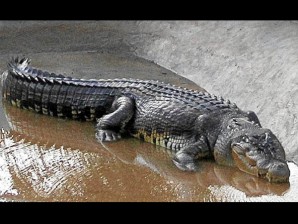
‘Lolong’. INQUIRER FILE PHOTO
MANILA, Philippines – The Protected Areas and Wildlife Bureau of the environment department is pressing the National Museum to expedite the stuffing and preservation of “Lolong,” the world’s biggest saltwater crocodile in captivity that died in Agusan del Sur last February.
PAWB Director Theresa Mundita Lim said the intact skin, including the skull, of the giant croc was placed in a freezer in the town of Bunawan in Agusan del Sur to preserve it for taxidermy. The National Museum will repair, stuff and stitch up the skin to retain the original shape and size of the beast for public exhibition.
“On their last visit, they said the skin was being preserved well in a freezer, but we are also urging the National Museum to hasten the process because the skin might rot,” she said, noting the frequent brownouts in Mindanao.
An Indo-Pacific croc, Lolong, was caught in Agusan Marsh and held the title of world’s largest captive crocodile for several months before it died of pneumonia in February. The title has since reverted to Australia’s Cassius.
Lim said a memorandum of understanding was to be signed between the Bunawan local government, the Department and Environment and Natural Resources, and the National Museum for the preservation of Lolong, which she described as a “national treasure.”
She said Bunawan officials wanted to remove Lolong’s skull and hang the skin on the wall to reduce maintenance costs.
But she said both the PAWB and the National Museum were of the opinion that stuffing the crocodile would be better appreciated by the public.
“They wrote us a letter reiterating their request to exhibit Lolong’s tanned skin, but we also insisted that tanning should not be the manner of preservation. Taxidermy will be more appreciated since it’s going to be more effective in information and education campaigns,” Lim said.
As for the rest of Lolong’s skeleton, she said, once the flesh has completely decomposed, the bones would be retrieved from the ground and used to create a replica.
“Since the skull cannot be removed from Lolong’s skin, we will have to create a replica of the skull,” she said.
Based on initial discussions, Lim said, the stuffed Lolong would likely be exhibited at the National Museum in Manila, while the replica made using the skeleton might stay in Bunawan. But nothing is final until the memorandum of understanding has been signed, she said.